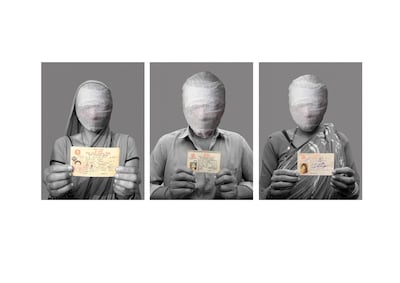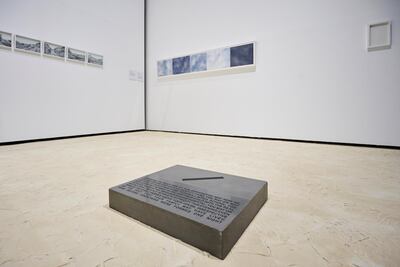Fabric(ated) Fractures is a show full of artworks that groan with despair. If that sounds like a criticism, it isn't. It's just that the subject of the exhibition – what is left behind when communities are displaced or when groups become frayed by arbitrarily imposed borders – is an emotive one. What is surprising, then, is how uplifting Fabric(ated) Fractures turns out to be.
Conceived in Bangladesh but featuring works by artists from four neighbouring countries, the show is a defiant riposte to colonialism – and, in fact, to all forms of religious or racial division (as the title makes clear, these fissures are nearly always man-made, although it is also true that Bangladesh is a country whose borders continue to shift because of ecological change). It is this defiance, rather than the ache of any individual painting, photograph or sculpture, that is most striking. Collective artistic endeavour here trumps political oppression.
In her foreword to the catalogue, Nadia Samdani, director of the Samdani Art Foundation, the Dhaka organisation that has brought many of these artworks to Dubai, writes: "This exhibition points to the plurality of religious and ethnic identities that make up the rich culture we experience in and around Bangladesh today." The subtext: don't you dare try and divide us.
Fabric(ated) Fractures is displayed at Concrete, one of the largest galleries at Alserkal Avenue, and it is to curator Diana Campbell Betancourt's great credit that she has not tried to fill every inch of space. Each artwork has been given room to breathe and the show feels composed, rather than frenzied or preachy, which it might easily have done given the highly politicised nature of some of the work.
Bangladeshi painter Kanak Chanpa Chakma's imposing abstract canvas, Soul Piercing, glowers at you from an otherwise empty wall. It is smudgy and cross. Soul Piercing is inspired by a tragedy that took place in Southern Bangladesh in 2012. A fake Facebook account, set up under a Buddhist name, posted an image of a burning Quran, which resulted in a period of violence towards Buddhist communities. Against a livid red acrylic background, Chakma has juxtaposed newspaper clippings from the time with peaceful images of Buddhist communities.
Walk around the corner and out of the vast floor appears a small, unassuming stone sculpture by Indian artist Shilpa Gupta. On this grey slab, with a slash mark at its head, Gupta has engraved a number of scenarios, including, "Depending on which side of this marking you may be, you may or may not have an identity card." Gupta was moved to make Untitled after visiting the enclaves of Bangladeshi land within India and Indian land within Bangladesh.
She highlights the absurdity of these borders with a series of photographs of the sky taken from these enclaves. How fluid it is up there; how rigid down here. And for what reason exactly?
A similar point is made even more emphatically by Nepalese artist Hitman Gurung, whose series of photographs, This is My Home, My Land and My Country, are the standout works here. Gurung has taken portraits of members of an indigenous community in Nepal, holding up their identity cards. Their faces have been covered by bandages. They are both recognised and not recognised. There is something unnerving about the bandaged faces – the stuff of childhood nightmares, perhaps – and yet look closely at the photographs on the identity cards and the fear melts away.
The spare way in which this space has been employed has also allowed for two large immersive installations to impose themselves without crowding out everything else. As you wander round the gallery, you can hear the gentle droning of the harmonium, a traditional Bangladeshi instrument, which is in danger of becoming obsolete.
This insistent noise comes from a looped video of Bangladeshi performance artist Reetu Sattar's Harano Sur (Lost Tune), in which 35 musicians play a sustained note on the harmonium (there have been a number of live performances as well). To have this sound nagging at you throughout is a reminder of how just durable culture and heritage tend to be, even when confronted with displacement and conflict.
Pakistani artist Ayesha Jatoi's Residue, meanwhile, is a series of piles of white garments, which the artist proceeds to slowly take from one side of the gallery and stack on the other. It is a seemingly senseless act but there is something ghostly about those neatly folded piles of clothes that haunt you. Why are some being removed before others?
Garments and textiles, the industry on which Bangladesh's economy is based, dominate one large area of Fabric(ated) Fractures. Alongside Jatoi's installation is Kamruzzaman Shadhin's Haven Is Elsewhere, which consists of refugee's clothes – swapped by the artist for new items – stitched together to create a bright and beautiful quilt from the threads of human despair.
The piece seems to call out to Thai artist Jakkai Siributr's collection of fake flags, The Outlaw's Flag, which he made using discarded bits and pieces found on the beaches in Myanmar and Thailand used by fleeing Rohingya refugees.
Fabric(ated) Fractures stands as a reminder that all sorts of different cultures will continue to blossom, healing wounds and re-establishing communities regardless of lines on a map. In the space left behind by fractures, the ground remains fertile.
Fabric(ated) Fractures is at Concrete, Alserkal Avenue, Dubai until March 30. For more information, visit
www.alserkalavenue.ae





